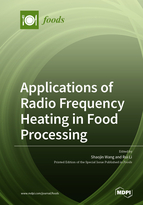Applications of Radio Frequency Heating in Food Processing
A special issue of Foods (ISSN 2304-8158). This special issue belongs to the section "Food Engineering and Technology".
Deadline for manuscript submissions: closed (20 September 2022) | Viewed by 32018
Special Issue Editors
2. Department of Biological Systems Engineering, Washington State University, Pullman, WA 99164-6120, USA
Interests: drying, disinfestation, and pasteurization of foods using RF energy
Special Issues, Collections and Topics in MDPI journals
Special Issue Information
Dear Colleagues,
Radiofrequency (RF) heating has been identified as one potential thermal treatment method to replace chemical fumigations and other conventional thermal methods because it is relatively easy to apply and leaves no chemical residues. RF equipment is commercially available today and is commonly used by the baking industry for the final drying of crackers and by other industries. It involves the direct transfer of electromagnetic energy into bulk materials, providing fast and volumetric heating.
This Special Issue aims to focus on recent developments and applications of RF heating in food processing, such as disinfestations, drying, pasteurization, sterilization, temping, and thawing. This Special Issue will provide major methods, research strategies, and protocols used in the development of environmentally friendly food processes based on RF energy.
Prof. Dr. Shaojin Wang
Dr. Rui Li
Guest Editors
Manuscript Submission Information
Manuscripts should be submitted online at www.mdpi.com by registering and logging in to this website. Once you are registered, click here to go to the submission form. Manuscripts can be submitted until the deadline. All submissions that pass pre-check are peer-reviewed. Accepted papers will be published continuously in the journal (as soon as accepted) and will be listed together on the special issue website. Research articles, review articles as well as short communications are invited. For planned papers, a title and short abstract (about 100 words) can be sent to the Editorial Office for announcement on this website.
Submitted manuscripts should not have been published previously, nor be under consideration for publication elsewhere (except conference proceedings papers). All manuscripts are thoroughly refereed through a single-blind peer-review process. A guide for authors and other relevant information for submission of manuscripts is available on the Instructions for Authors page. Foods is an international peer-reviewed open access semimonthly journal published by MDPI.
Please visit the Instructions for Authors page before submitting a manuscript. The Article Processing Charge (APC) for publication in this open access journal is 2900 CHF (Swiss Francs). Submitted papers should be well formatted and use good English. Authors may use MDPI's English editing service prior to publication or during author revisions.
Keywords
- disinfestation
- drying
- pasteurization
- sterilization
- temping
- thawing








